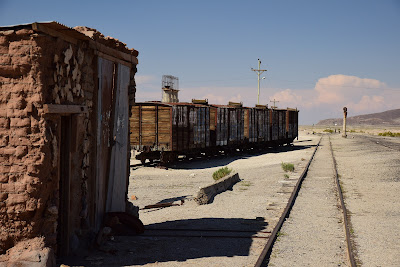We passed 3 more beautiful lagoons before stopping at one called the Stinky Lagoon due to the sulphur but just beautiful and populated with huge flocks of flamingos.
From there we headed across country cutting between two mountains and through a rocky canyon which is perfect territory for the little Viscacha which we all wanted to see. The guide knowing this had brought some carrots which they love so within minutes we had these wild rabbit like animals taking carrots from our hands.
 |
| La Rocas...25Km of volcanic distruction huge ravine on the other side of the stones |
Bolivians believe in Pachamama (Mother Earth) rather than a religion and so believe that things like the geysers are a sign that Pachamama is alive and eruptions are expressions of discontent etc. All of this mixed in with bits of catholisism from the Conquistador era.
 |
| No chance of a bus here !! |
 |
| Old village ghose town outside of Pulaca |
From there on to Pulaca which had once been a very important town as it had been the end stop for the first railway line to be built near the salt flats.
Prior to this, all the salt was brought out in bundles using llamas (horses can’t work at these altitudes but llamas are perfectly adjusted) so the arrival of the railway was a huge deal and made Pulaca a very important place.
 |
| Just like the spaghetti westerns |
That was then and this is now and now it is another tumbleweed town with derelict railway carriages, lines, water fillers and a desolate feel. Steve of course loved it as his favourite thing is to photograph dereliction and wrecks !!
Coca leaves (the basic material for cocaine) are very much part of life in Bolivia. They even have ot in all the hotels.
They are chewed by the locals to help with altitude, they are made into teas mixed with aniseed and camomile and are widely sold in markets and shops. The USA as part of their crack down on drugs dictate how much Coca Bolivia can produce which is just enough for local usage. People here don’t understand why the west is so anti and are currently trying to negotiate with the USA for larger quotas but are unlikely to get them in case it encourages drug production as it did in Columbia. They are also trying to persuade western governments of the health benefits of Coca so they can export small quantities for medicinal purposes. Steve declined to have coca in any form preferring to suffer in silence (we wish !!)
 |
| Oh yes...yet another volcano. Our volcano count is now in the hundreds |
 |
| The dryness ensured that remains had been perfectly preserved for thousands of years. |
Scare alert! The indigenous people realised that the volcanic rock was hollow and then used these as places to bury their dead. Generations in layers within some of the rock formations. Due to the dryness & the altitude very little decays here and some of the mummies still had fabric intact. They believe in an afterlife so they were often buried with the tools of their trade along with foodstuff usually Quinoa. All in all a very weird feeling looking in at these people from long ago..............
 |
| Hundreds of graves in the open with all remains perfectly preserved...very ghoulish!! All these are carved out of natural coral which is used as a building material here |
The local people have always made their living from Quinoa production & Llamas and nothing has changed for generations here. There are still acres & acres of Quinoa and Bolivia accounts for up to 46% of the world Quinoa production and most of the best quality as all their farming methods are organic. The only diffrence now is that after it is harvested & dried it is shipped to large processing plants before going onwards to be sold to the major export companies.
 |
| Our second high altitude hotel |
This is another of the community hotels and while very rustic was just charming and our rooms had lovely views over the little town.
 |
| The old town...result of Bolivias seemingly many battle defeats |
In this town is a little castle and the reason for this is they call it the Burnt Town and it commemorates the defeat of Bolivia in the Pacific Wars. The Chileans invaded here while the men were away fighting and destroyed the town and killed all the women and children. As the houses were all stone, it was the straw roofs that burned, so the remnants of the original town are clear to see even today.
 |
| The castle tower |
By this time and at this altitude we were all exhausted, so one beer each and another communal dinner in a cozy little dining room and we were all out for the count. This part of the holiday is certainly regulating our alcohol intake big time !!
 |
| A baby Llama (pronounced "yama" Janette loves these so there will probably be one on every day of the blog.. |
























































